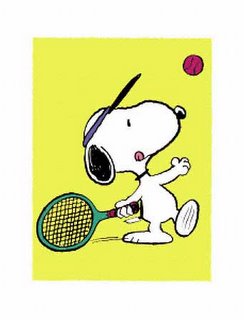First off, congratulations to Venus Williams. In winning her 4th Wimbledon crown (6th slam overall), Ms. Williams put on a devastating display of power, touch, and skill. She dismantled Maria Sharapova, Svetlana Kuznetsova, and Anna Ivanovic before soundly defeating a game but overmatched Marion Bartoli in the final. Mary Carillo summed up one of the reasons people have a problem with the Williams sisters. Namely, both seem capable of winning every match and tournament to which they set their minds and their considerable talents. Of course, the fact that they're confident and outspoken African-American women has nothing to do with it. Ahem.
Some other random thoughts on the women's draw:
Justine Henin: Wimbledon seems to bring out some strange weaknesses in her game and her psyche.
Maria Sharapova: I've now seen her get destroyed in three straight slams, managing to win a total of only 10 games.
Serena Williams: I felt bad for Serena losing to the one player (Henin) to whom she really didn't want to lose. Still, I like the fact that, win or lose, she speaks her mind. Some call it arrogance, I call it refreshing honesty.
Anna Ivanovic: This year's "It" girl actually has some game. Still, the only way she was going to beat Venus Williams in the semis was with a sledgehammer.
I did not want to see Roger Federer win. Pete Sampras was always my favorite player, and it's been real tough watching Fed march inexorably toward slam #15. Still, Rafael Nadal made him earn this one, and both players deserve props for showing why they're head and shoulders above everyone else in men's tennis.
Nadal had his chances. He lost both tiebreakers. He had double break points against Federer in the third and fifth games of the final set. At that point, I really thought he had the championship. Federer showed me a lot, though. No one had ever questioned his talent, but many sportswriters and fans (myself included) had wondered how he'd respond when truly tested. He responded with his 5th consecutive Wimbledon title. I thought I saw Bjorn Borg wince, but they may have just been a figment of my imagination.
Thoughts on the men's draw:
Novak Djokovic: Won a lot of fans with his hard-fought win against Marcos Baghdatis in the quarters. He then lost some fans when he retired in the third set (trailing 1-4) against Nadal. I'm actually predicting a Djokovic win at the U.S. Open.
Richard Gasquet: Has the best backhand in the business. He showed why some think he's every bit as talented as Federer. Coming back against Roddick in the quarters should be a sign of things to come. Allez, Richard!
Andy Roddick: Sigh. I felt bad for Roddick. I'd actually predicted a Gasquet win, but I didn't expect Andy to go out like that. He led 2 sets to 0 and was up a break in the third before it all fell apart for him. Gasquet didn't expose his weaknesses. He simply exploited the "gaps" in Roddick's game (backhand, deficiencies at net) that everyone already knew.
So, now it's on to the hardcourt season.





